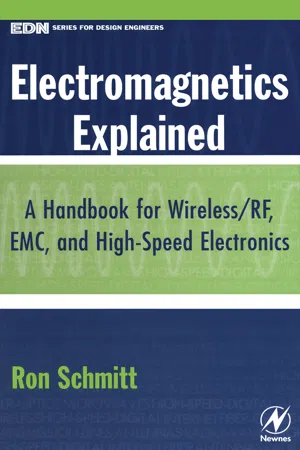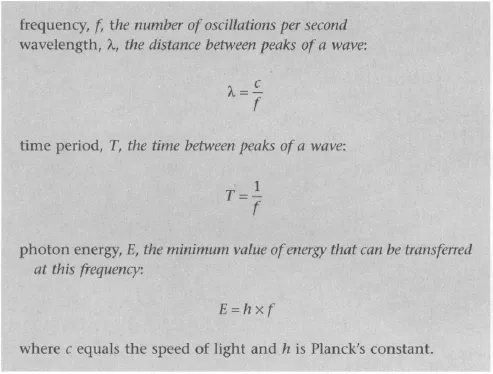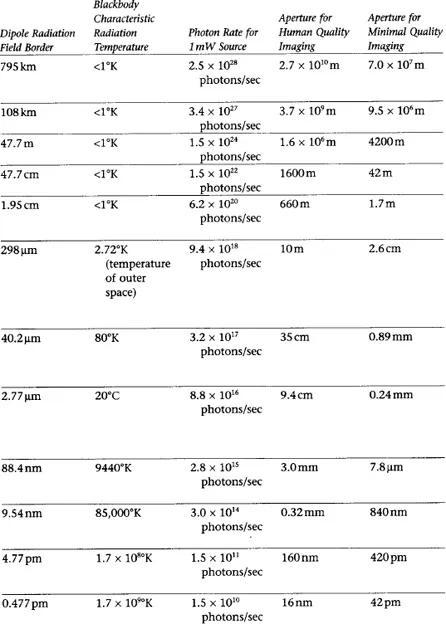
eBook - ePub
Electromagnetics Explained
A Handbook for Wireless/ RF, EMC, and High-Speed Electronics
Ron Schmitt
This is a test
Share book
- 410 pages
- English
- ePUB (mobile friendly)
- Available on iOS & Android
eBook - ePub
Electromagnetics Explained
A Handbook for Wireless/ RF, EMC, and High-Speed Electronics
Ron Schmitt
Book details
Book preview
Table of contents
Citations
About This Book
Approx.410 pagesApprox.410 pages
Frequently asked questions
How do I cancel my subscription?
Can/how do I download books?
At the moment all of our mobile-responsive ePub books are available to download via the app. Most of our PDFs are also available to download and we're working on making the final remaining ones downloadable now. Learn more here.
What is the difference between the pricing plans?
Both plans give you full access to the library and all of Perlego’s features. The only differences are the price and subscription period: With the annual plan you’ll save around 30% compared to 12 months on the monthly plan.
What is Perlego?
We are an online textbook subscription service, where you can get access to an entire online library for less than the price of a single book per month. With over 1 million books across 1000+ topics, we’ve got you covered! Learn more here.
Do you support text-to-speech?
Look out for the read-aloud symbol on your next book to see if you can listen to it. The read-aloud tool reads text aloud for you, highlighting the text as it is being read. You can pause it, speed it up and slow it down. Learn more here.
Is Electromagnetics Explained an online PDF/ePUB?
Yes, you can access Electromagnetics Explained by Ron Schmitt in PDF and/or ePUB format, as well as other popular books in Technology & Engineering & Signals & Signal Processing. We have over one million books available in our catalogue for you to explore.
Information
1 INTRODUCTION AND SURVEY OF THE ELECTROMAGNETIC SPECTRUM
How does electromagnetic theory tie together such broad phenomena as electronics, radio waves, and light? Explaining this question in the context of electronics design is the main goal of this book. The basic philosophy of this book is that by developing an understanding of the fundamental physics, you can develop an intuitive feel for how electromagnetic phenomena occur. Learning the physical foundations serves to build the confidence and skills to tackle real-world problems, whether you are an engineer, technician, or physicist.
The many facets of electromagnetics are due to how waves behave at different frequencies and how materials react in different ways to waves of different frequency. Quantum physics states that electromagnetic waves are composed of packets of energy called photons. At higher frequencies each photon has more energy. Photons of infrared, visible light, and higher frequencies have enough energy to affect the vibrational and rotational states of molecules and the electrons in orbit of atoms in the material. Photons of radio waves do not have enough energy to affect the bound electrons in a material. Furthermore, at low frequencies, when the wavelengths of the EM waves are very long compared to the dimensions of the circuits we are using, we can make many approximations leaving out many details. These low-frequency approximations give us the familiar world of basic circuit theory.
THE NEED FOR ELECTROMAGNETICS
So why would an electrical engineer need to know all this theory? There are many reasons why any and all electrical engineers need to understand electromagnetics. Electromagnetics is necessary for achieving electromagnetic compatibility of products, for understanding high-speed digital electronics, RF, and wireless, and for optical computer networking.
Certainly any product has some electromagnetic compatibility (EMC) requirements, whether due to government mandated standards or simply for the product to function properly in the intended environment. In most EMC problems, the product can be categorized as either an aggressor or a victim. When a product is acting as an aggressor, it is either radiating energy or creating stray reactive fields at power levels high enough to interfere with other equipment. When a product is acting as a victim, it is malfunctioning due to interference from other equipment or due to ambient fields in its environment. In EMC, victims are not always blameless. Poor circuit design or layout can create products that are very sensitive to ambient fields and susceptible to picking up noise. In addition to aggressor/victim problems, there are other problems in which noise disrupts proper product operation. A common problem is that of cabling, that is, how to bring signals in and out of a product without also bringing in noise and interference. Cabling problems are especially troublesome to designers of analog instrumentation equipment, where accurately measuring an external signal is the goal of the product.
Moreover, with computers and networking equipment of the 21st century running at such high frequencies, digital designs are now in the RF and microwave portion of the spectrum. It is now crucial for digital designers to understand electromagnetic fields, radiation, and transmission lines. This knowledge is necessary for maintaining signal integrity and for achieving EMC compliance. High-speed digital signals radiate more easily, which can cause interference with nearby equipment. High-speed signals also more often cause circuits within the same design to interfere with one another (i.e., crosstalk). Circuit traces can no longer be considered as ideal short circuits. Instead, every trace should be considered as a transmission line because reflections on long traces can distort the digital waveforms. The Internet and the never-ending quest for higher bandwidth are pushing the speed of digital designs higher and higher. Web commerce and applications such as streaming audio and video will continue to increase consumer demand for higher bandwidth. Likewise, data traffic and audio and video conferencing will do the same for businesses. As we enter the realm of higher frequencies, digital designs are no longer a matter of just ones and zeros.
Understanding electromagnetics is vitally important for RF (radio frequency) design, where the approximations of electrical circuit theory start to break down. Traditional viewpoints of electronics (electrons flowing in circuits like water in a pipe) are no longer sufficient for RF designs. RF design has long been considered a “black art,” but it is time to put that myth to rest. Although RF design is quite different from low-frequency design, it is not very hard to understand for any electrical engineer. Once you understand the basic concepts and gain an intuition for how electromagnetic waves and fields behave, the mystery disappears.
Optics has become essential to communication networks. Fiber optics are already the backbone of telecommunications and data networks. As we exhaust the speed limits of electronics, optical interconnects and possibly optical computing will start to replace electronic designs. Optical techniques can work at high speeds and are well suited to parallel operations, providing possibilities for computation rates that are orders of magnitude faster than electronic computers. As the digital age progresses, many of us will become “light engineers,” working in the world of photonics. Certainly optics is a field that will continue to grow.
THE ELECTROMAGNETIC SPECTRUM
For electrical engineers the word electromagnetics typically conjures up thoughts of antennas, transmission lines, and radio waves, or maybe boring lectures and “all-nighters” studying for exams. However, this electrical word also describes a broad range of phenomena in addition to electronics, ranging from X-rays to optics to thermal radiation. In physics courses, we are taught that all these phenomena concern electromagnetic waves. Even many nontechnical people are familiar with this concept and with the electromagnetic spectrum, which spans from electronics and radio frequencies through infrared, visible light, and then on to ultraviolet and X-rays. We are told that these waves are all the same except for frequency. However, most engineers find that even after taking many physics and engineering courses, it is still difficult to see much commonality across the electromagnetic spectrum other than the fact that all are waves and are governed by the same mathematics (Maxwell’s equations). Why is visible light so different from radio waves? I certainly have never encountered electrical circuits or antennas for visible light. The idea seems absurd. Conversely, I have never seen FM radio or TV band lenses for sale. So why do light waves and radio waves behave so differently?
Of course the short answer is that it all depends on frequency, but on its own this statement is of little utility. Here is an analogy. From basic chemistry, we all know that all matter is made of atoms, and that atoms contain a nucleus of protons and neutrons with orbiting electrons. The characteristics of each element just depend on how many protons the atom has. Although this statement is illuminating, just knowing the number of protons in an atom doesn’t provide much more than a framework for learning about chemistry. Continuing this analogy, the electromagnetic spectrum as shown in Figure 1.1 provides a basic framework for understanding electromagnetic waves, but there is a lot more to learn.

Figure 1.1 The electromagnetic spectrum.
To truly understand electromagnetics, it is important to view different problems in different ways. For any given frequency of a wave, there is also a corresponding wavelength, time period, and quantum of energy. Their definitions are given below, with their corresponding relationships in free space.

Depending on the application, one of these four interrelated values is probably more useful than the others. When analyzing digital transmission lines, it helps to compare the signal rise time to the signal transit time down the transmission line. For antennas, it is usually most intuitive to compare the wavelength of the signal to the antenna length. When examining the resonances and relaxation of dielectric materials it helps to compare the frequency of the waves to the resonant frequency of the material’s microscopic dipoles. When dealing with infrared, optical, ultraviolet, and X-ray interactions with matter, it is often most useful to talk about the energy of each photon to relate it to the orbital energy of electrons in atoms. Table 1.1 lists these four values at various parts of the electromagnetic spectrum, and also includes some other relevant information. If some of these terms are unfamiliar to you, don’t fret—they’ll be explained as you progress through the book.
Table 1.1 Characteristics of Electromagnetic Waves at Various Frequencies


ELECTRICAL LENGTH
An important concept to aid understanding of electromagnetics is electrical length. Electrical length is a unitless measure that refers to the length of a wire or device at a certain frequency. It is defined as the ratio of the physical length of the device to the wavelength of the signal frequency:

As an example, consider a 1-meter long antenna. At 1 kHz this antenna has an electrical length of about 3 × 10-6. An equivalent way to say this is in units of wavelength; that is, a 1 meter antenna is 3 × 10-6 λ long at 1 kHz. At 1 kHz this antenna is electrically short. However, at 100 MHz, the frequency of FM radio, this antenna has an electrical length of 0.3 and is considered electrically long. In general, any device whose electrical length is less than about 1/20 can be considered electrically short. (Beware: When working with wires that have considerable loss or large impedance mismatches, even electrical lengths of 1/50 may not be electrically short.) Circuits that are electrically short can in general be fully described by basic circuit theory without any need to understand electromagnetics. On the other hand, circuits that are electrically long require RF techniques and knowledge of electromagnetics.
At audio frequencies and below (<20 kHz), electromagnetic waves have very long wavelengths. The wavelength is typically much larger than the length of any of the wires in the circuit used. (An exception would be long telephone lines.) When the wavelength is much longer than the wire lengths, the basic rules of electronic circuits apply and electromagnetic theory is not necessary.
THE FINITE SPEED OF LIGHT
Another way of looking at low-frequency circuitry is that the period (the inverse of frequency) of the waves is much larger than the delay through the wires. “What delay in the wires?” you might ask. When we are involved in low-frequency circuit design it is easy to forget that the electrical signals are carried by waves and that they must travel at the speed of light, which is very fast (about 1 foot/nsec on open air wires), but not infinite. So, even when you turn on a li...